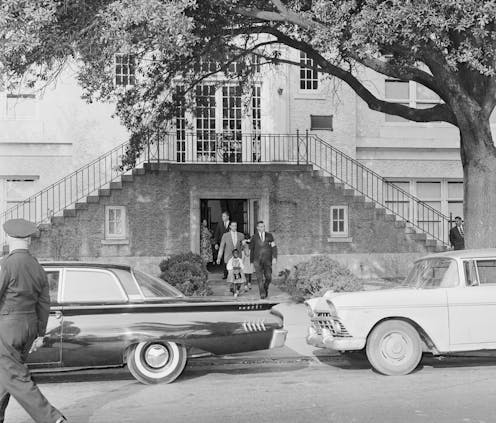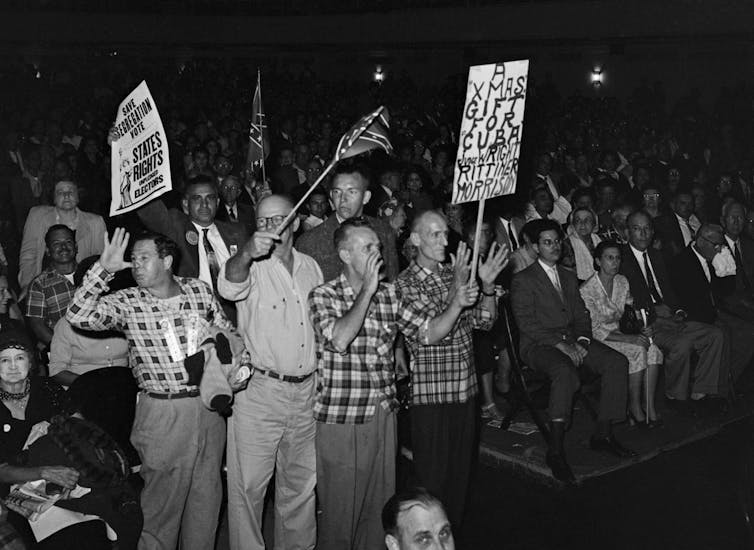New Orleans schools still separate and unequal 70 years after Brown v. Board of Education
On Nov. 15, 1960, four Black first graders desegregated New Orleans schools. One of them was Tessie Prevost, who died in July 2024 with the promises of the post-Brown era still unfulfilled.

Sixty-four years ago this November, public schools in New Orleans began to desegregate. School buildings once designated as “white” opened their doors to Black students. The integration process, which deeply divided the city, was led by four first-grade girls.
Tessie Prevost, Leona Tate and Gail Etienne were the first Black students to attend the McDonogh 19 School. Ruby Bridges was assigned to the previously all-white William Frantz Public School. Newspapers worldwide ran photographs of the girls walking past protesters and entering the schools accompanied by federal marshals.
When Prevost died in July 2024, she was lauded as a Civil Rights hero. Oprah Winfrey paid tribute to her at the Democratic National Convention.
Prevost herself did not realize her role in history until high school, when a teacher assigned the class a project on Brown v. Board of Education, the 1954 U.S. Supreme Court ruling that desegregated American schools. As she researched, she discovered her own name and story. She took this discovery to her parents, and they gave her a box of photographs and letters about her place in history, including a note from Eleanor Roosevelt praising her courage.
To some, Prevost represents the promises of the Civil Rights Movement: integration and equality. As our research on New Orleans Public Schools shows, however, neither of these promises has ever been fully realized.
New Orleans’schools resegregated in the late 20th century, and the city’s predominantly Black schools still lag behind white schools in many ways.
‘All deliberate speed’
In the landmark 1954 U.S. Supreme Court decision Brown v. Board of Education, the justices ordered U.S. public schools to desegregate “with all deliberate speed” – language that allowed Southern cities and states to drag their heels.
New Orleans schools did not begin desegregating for six years. Even then, only four first-grade girls out of thousands of Black students were permitted to enroll in white schools.
The New Orleans district would subsequently desegregate one additional grade per year. As a member of that first desegregated class, Prevost was always in the grade being integrated. As such, all the grades above her remained segregated.
Indeed, McDonogh 19 remained segregated during the first year of integration because all its white students immediately stopped attending. By December 1960, the school’s only students were the three Black girls. Two white students briefly enrolled in January, but their family succumbed to the pressure of the boycott and soon withdrew their children.

When Prevost, Etienne and Tate entered second grade, McDonogh 19 still had very low enrollment. In third grade, in 1962, the girls transferred to T.J. Semmes Elementary School, where enrollment of white students was much higher.
Within that white student majority, the girls encountered many cruel classmates. White students, encouraged by some teachers and parents, tormented their Black peers. Prevost recalled this as the worst time in her life.
“The white teachers and students did not want us there,” she said. “Every day there were beatings and cursing. They spat on us and ripped off our clothes.”
After several years, Prevost’s parents recognized the impact of this heinous racism on their daughter and transferred her into a predominantly Black junior high school. Prevost would again be separated from most of her white peers.
Equality in name only
The Brown ruling also promised an equal education regardless of race. In practice, that has yet to happen.
Most white teachers in New Orleans opposed desegregation, and the district initially allowed teachers to choose where they would teach. In 1972, however, the district reassigned many teachers to work in desegregated schools, and many quit in protest. Other white teachers struggled to connect and engage with their Black students, leading to disaffection among Black students. Their academic achievement declined, and dropout rates began to rise.
Simultaneously, white flight was working against integration. Between 1960 and 1980, the white population of New Orleans dropped 20%, resegregating many New Orleans schools. By 2004, 50 years after the Brown ruling, McDonogh 19 – which by then had been renamed Louis Armstrong Elementary – was again effectively segregated by race: Nearly 100% of its students were Black.
Across the district, academic performance declined in predominantly Black schools. By the 1990s, student achievement became increasingly measured by standardized tests known to be biased against students of color and poor students. Black students were also more likely to be taught by teachers with fewer years of experience and less education.
By 1998, test scores at Louis Armstrong Elementary had fallen well below national, state and district averages. The school was also in a state of deep disrepair. In the summer of 2005, the city closed the school, and a few months later, Hurricane Katrina hit New Orleans.
The abandoned school building sustained heavy wind damage and flooding. Water reached halfway up the walls of the first floor, leaving toxic mud, peeling chalkboards and mold-encrusted furniture.
A legacy
Following Katrina, the State Board of Education stripped New Orleans Public School District of its authority to manage public education.
The state of Louisiana and charter organizations took over city schools, making New Orleans Public Schools the first all-charter school district in the U.S. Despite the change in governance, New Orleans schools remained segregated by race. Over a decade later, in 2017, roughly 75% of schools had populations of 95% students of color, and test scores showed only incremental improvement.
Prevost, whose married name was Tessie Williams, lived in New Orleans her whole life, working at Louisiana State University for over two decades.
She returned to McDonogh 19 in 2022, when the restored building opened as the Tate, Etienne and Prevost Center. The site, once a symbol of resistance to civil rights, is now a community center and museum committed to advancing the unfulfilled promises of the Brown ruling.
As an adult, when Prevost spoke publicly about desegregation, she recalled the difficulty and disappointment she and others faced. But she tended to emphasize her hope for the future.
“The ways that we are different are things that we should celebrate,” she said in a Black History Month interview with Louisiana State University. “There is so much power and freedom when we see differences in a positive light.”
The authors do not work for, consult, own shares in or receive funding from any company or organization that would benefit from this article, and have disclosed no relevant affiliations beyond their academic appointment.
Read These Next
The celibate, dancing Shakers were once seen as a threat to society – 250 years later, they’re part
‘The Testament of Ann Lee,’ Mona Fastvold’s 2025 film, depicts part of the long history of Shaker…
As DOJ begins to release Epstein files, his many victims deserve more attention than the powerful me
Powerful men connected to Jeffrey Epstein are named, dissected and speculated about. The survivors,…
How to reduce gift-giving stress with your kids – a child psychologist’s tips for making magic and a
Depending on family circumstances and a child’s personality type, gift giving runs the gamut of fun…






